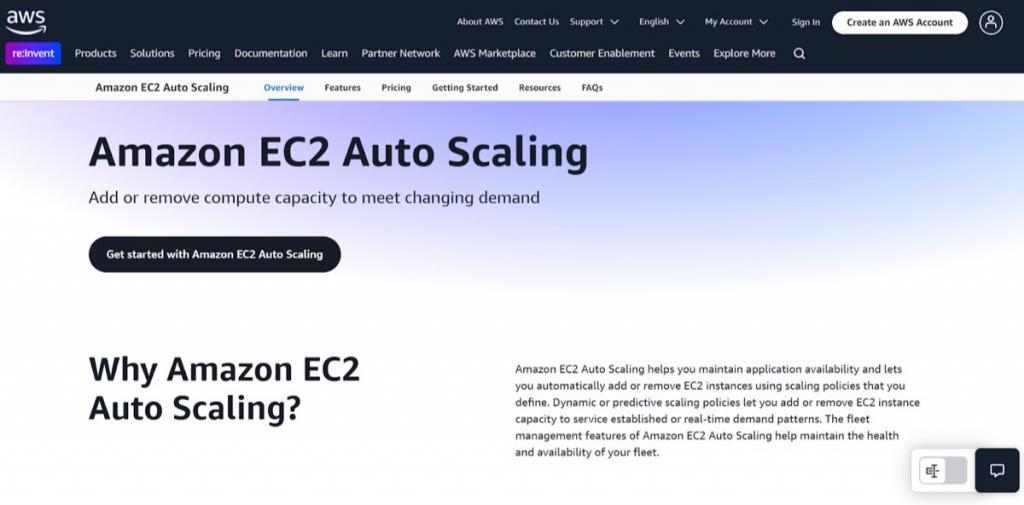
Key Strategies for Scaling Your Website To Drive Revenue Growth
Scaling your website can help you reach more people and grow your revenue. With the right strategies, you can improve performance, keep visitors engaged, and turn traffic into results.
This guide will show you simple ways to make it happen.
1. Use Scalable Website Infrastructure
Without a solid foundation, website traffic surges will slow down or crash your site.
Use Cloud-Based Hosting 
Providers like AWS, Google Cloud, or managed hosting services offer plans that automatically adjust resources to handle traffic spikes. Look for options such as pay-as-you-go pricing or auto-scaling plans, which let you scale up or down based on traffic demand.
For example, AWS’s EC2 Auto Scaling and Google Cloud’s Compute Engine allow you to add or reduce server capacity as needed, so you only pay for the resources you use. This flexibility ensures your website stays reliable and cost-efficient as it grows.

AWS’s EC2 Auto Scaling page
Implement a Content Delivery Network (CDN)
CDNs like Cloudflare or Akamai store copies of your site’s content on servers worldwide. This speeds up load times for visitors by serving content from the nearest server while also reducing strain on your main hosting server.
For example, if your main server is in New York and a visitor from Tokyo accesses your site, the CDN will deliver the content from a nearby server in Asia instead of the one in New York.
Optimize Server-Side Caching and Image Compression
Enable server-side caching to reduce load times for repeat visitors by storing frequently used data. Compress large images using tools like TinyPNG or ImageOptim to keep file sizes small without losing quality. Regularly check your site for any oversized files or unoptimized scripts that could slow things down.
2. Improve Website Conversion Rates
Driving more traffic to your site is great, but it won’t grow your revenue unless visitors take action. Here’s how to optimize conversions:
Optimize CTAs, Landing Pages, and Checkout Flows
Experiment with different call-to-action (CTA) buttons, headlines, and page layouts to see what works best. Simplify your checkout process to reduce friction and avoid abandoned carts.
For example, if you run an e-commerce website, you can take inspiration from Benefit Cosmetics. Their homepage features a variety of well-placed, action-driven CTAs to guide visitors seamlessly. When you land on the site, a prominent “Shop Now” button immediately directs users to holiday sales.

Benefit Cosmetics homepage
As you scroll, they continue to use relevant CTAs like “Get It Now” under bestselling products and “Book Me” for beauty services. Each CTA is tailored to its section, encouraging visitors to take specific actions, whether it’s shopping, exploring, or booking—ultimately driving engagement and conversions.
Use A/B Testing Tools
A/B testing tools like Optimizely allow you to create and compare two versions of a webpage—such as different button colors, headlines, or images—to see which one leads to better results, like more clicks or purchases.
For example, you can test a red “Buy Now” button (version A) against a green one (version B). The tool will split your visitors randomly between the two versions and track which one performs better based on conversions or engagement.
Analyze Visitor Behavior
Tools like Hotjar or Crazy Egg help you see how visitors interact with your website through heatmaps and session recordings.
- Heatmaps show where users click, scroll, or hover the most. For example, if you notice users aren’t clicking on a call-to-action (CTA) button, it may be because it’s not visible or engaging enough.
- Session recordings let you watch how individual users move through your site. You can see where they get stuck, drop off, or abandon a purchase.
These insights help you spot issues like poorly placed buttons, confusing layouts, or content visitors ignore. Fixing these areas can improve the user experience and guide visitors toward completing actions, like making a purchase or signing up.
3. Enhance Content and User Experience (UX)
A website with rich, engaging content and a smooth user experience keeps visitors interested, reduces bounce rates, and increases conversions.
Incorporate Multimedia Content
Use a variety of formats like videos, product presentations, and digital catalogs to make your content more engaging. Tools like InVideo help create professional product videos, while interactive catalogs can give customers an immersive look at your offerings.
For visuals, you can use AI image generators like Imagine Anything to quickly create high-quality, unique images or illustrations tailored to your website’s needs.
Combining multimedia content and visuals keeps your website engaging, professional, and appealing to visitors.
Make Navigation and Layout User-Friendly
When your site feels easy to explore, visitors are more likely to stay and find what they need. Start with a simple, well-organized menu—too many options can confuse people, so focus on clear categories and group similar content together.
If you have extra pages, dropdown menus can help keep things tidy. Place important links, like a search bar or contact page, where visitors expect to see them, such as the top of the page. Finally, keep your layout clean and free of distractions so visitors can focus on the most important content. The smoother the experience, the more likely they’ll stick around and take action.
Showcase Your Website Across Platforms
Share your website on trusted review platforms like Capterra, Siteefy or G2 to increase visibility and build credibility. Real user reviews help showcase the value of your site and build trust with new visitors.
If your website provides tools or unique features, submit them to platforms or websites that focus on tool testing or evaluations. For example, Siteefy offers custom tool testing services, where they test your tool and share it with their readers. This helps potential users learn more about what your tool does, how it works, and its benefits, giving your tool greater visibility and drawing interested audiences to your site. It can also give you a better idea of how to further improve your product based on the test results.
4. Streamline Email Marketing for Scalability
Another way to grow your website and drive revenue is through email marketing. As one of the most effective tools for nurturing leads and keeping customers engaged, email can help turn visitors into loyal buyers and maximize customer lifetime value (LTV).
To do this, follow these tips:
Set Up Automated Workflows
Automating your emails saves time and keeps your communication timely and relevant. Platforms like Mailchimp let you set up workflows for essential campaigns, such as welcome series for new subscribers, cart recovery emails for abandoned purchases, and post-purchase follow-ups to encourage repeat business.
Segment Your Audience
Not all customers are the same, so segmenting your email list helps you send more personalized and effective messages. Divide your audience based on their behavior, interests, or purchase history.
For example, send product recommendations to repeat buyers or exclusive discounts to those who haven’t purchased in a while. Targeted campaigns often lead to higher open rates and conversions.
Design Clean and Engaging Email Templates
For effective email campaigns, well-designed templates help your message look professional, organized, and easy to follow. Clean layouts, structured content, and appealing visuals make your emails more engaging and memorable.
You can use simple drag-and-drop email builders like Mailtrap email builder to quickly create branded templates that match your style. These tools make it easy to customize and design emails that look polished and leave a strong impression on your audience, helping you drive better results.
5. Focus on User Retention and Upselling
Keeping your existing users engaged and satisfied costs less than acquiring new ones, and it often leads to higher long-term revenue.
Specific Actions
- Implement Loyalty Programs &Personalized Offers: Reward your loyal customers with programs that offer points, discounts, or exclusive perks. For instance, a loyalty program where customers earn points for purchases or referrals encourages repeat business. Adding personalized offers based on purchase history, like discounts on products they’ve bought before, makes customers feel valued and keeps them coming back.
- Use Behavioral Triggers for Upselling and Cross-Selling: Encourage customers to buy more by suggesting products or upgrades that match their needs. For example, if someone buys a laptop, recommending accessories like a case or mouse is an effective cross-sell. Behavioral triggers such as “Customers also bought” suggestions or limited-time offers can further increase order value and improve the shopping experience.
- Improve the Post-Purchase Experience
A great experience doesn’t end at checkout. Follow up with customers after their purchase to keep them engaged. Send thank-you emails, share helpful guides on using their new product, or offer additional support. For example, a clothing store might send styling tips, while a tech store could offer setup instructions. These small touches build trust and keep customers connected to your brand.
Final Thoughts
If you’re looking to grow your website’s revenue, these tips will set you on the right path. That said, the digital world is always changing, so it’s important to stay open to new trends and strategies.
Keep an eye on what’s working, try fresh ideas, and adapt as you go to keep your website thriving.
